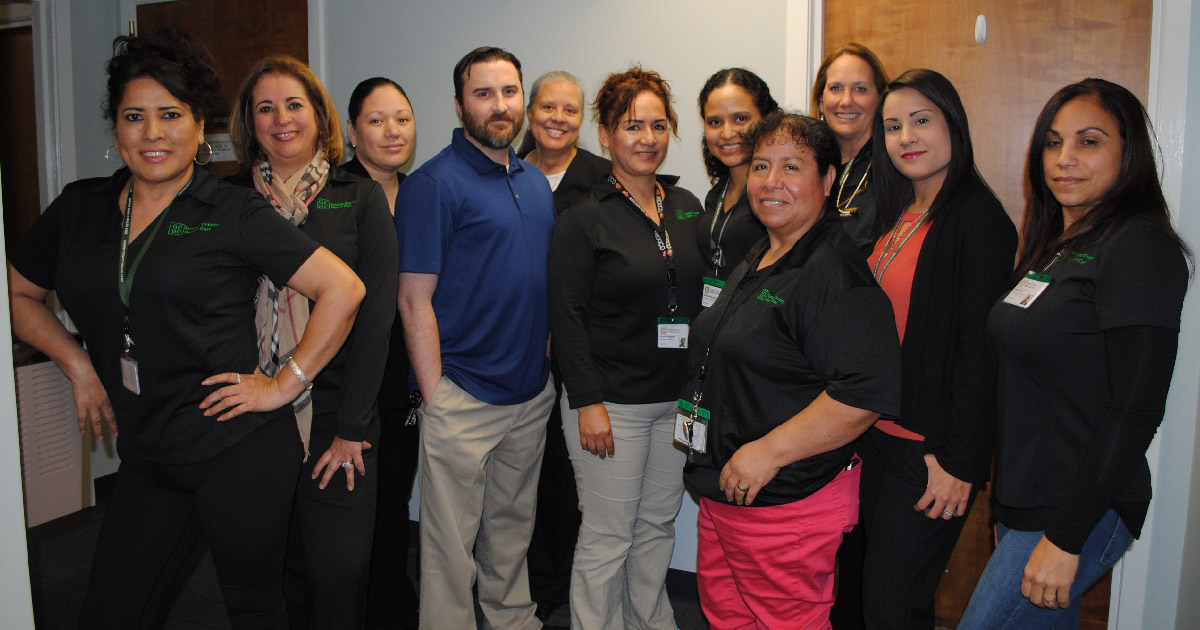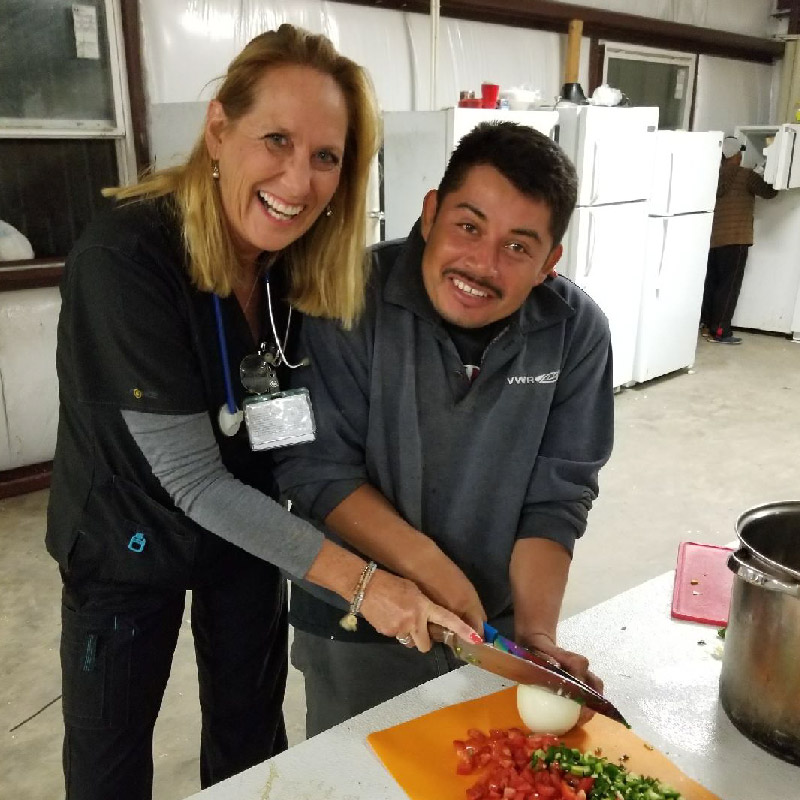Diabetes, Disasters, Late Night Outreach: The Life of a Migrant & Neighborhood Health Nurse in North Carolina

[The Greene County Health Care staff. Gena Byrd is third from the right.]
“It’s very, very busy this time a year.” That’s the update from Gena Byrd, RN, a nurse with Greene County Health Care, a community health center in North Carolina. One of the true migrant health centers, Greene County supports its mobile agricultural workers through a robust in-the-field program, through which Byrd logs many miles in her car across the 17 counties her health center serves during the growing season.
“We see a variety of camps. Some may be as small as a few guys on a farm, with more coming later, or we might have camps with 300 workers,” Byrd described. She drives out with a team to agricultural worker housing, be it small homes, trailers, revamped hotels, and large barracks; or she heads to community events like festivals, flea markets, and church events -- anything to get out in the community. In mid-May, she was headed out to a fair at 6pm, and planned to get back around 11:30. That weekend, she planned to go to a Latino festival after a Sunday flea market, and expected to be on the road from 6am until after 8pm. Her schedule is packed many evenings and weekends from mid-April through September or October. Byrd admits that the ebbs and flows of the work, which require significant engagement during the summer, don’t work for many, but she manages: “My kids are grown, I have a supportive husband,” she explained. Byrd is supported by a diverse team both with her in the field and back at the health center, with case workers, enrollment specialists, community health workers, health educators, behavior health coaches, and nurses all working to improve the health of the mobile agricultural workers living in the community for the summer.
Because Byrd’s work is dependent on the agricultural workers’ needs, and the number of workers fluctuates, each season is different. “In North Carolina, I think we’re seeing a decline in H2A workers because of tobacco,” she said. Tobacco, a major crop in her corner of the country, has changed in recent years, with many small farms being bought out by larger corporations. As smaller farmers are pushed out, so too are the workers. Additionally, weather patterns have changed over time, which, for this year at least, has shifted the season. Byrd reported that by mid-May fields hadn’t yet been turned over for the annual crops like sweet potatoes, corn, and soybeans, which indicates a late start.
Last year’s Hurricane Florence devastated large swaths of North Carolina, and Byrd and her team -- they are about an hour and a half from the coast -- kicked into high gear when major flooding affected their region. “In those types of situations, we print out information to take to the farm camps. We may go to 20 houses a day just delivering information,” Byrd said. The brochures, in Spanish, give them practical information on who to call and what they should bring when evacuating. “Sometimes we help at the shelters as translators or interpreters,” Byrd said. “And after the whole thing is over and they’re heading back home, we work with the local interfaith communities and food banks and we provide transportation to get people there, to get them the food they need.” After immediate needs like food, which is destroyed by the floodwaters, are addressed, Byrd and her team expand their work to match other critical needs, like coordinating volunteers from a local ministry to replace moldy walls. “I had a lady whose fridge went bad. I had an extra one, and [volunteers] helped me move it to her home,” Byrd recalled. Almost nine months after the hurricane, many communities are still trying to pick up the pieces and rebuild.

[Gena Byrd in the kitchen with H2A farmworkers.]
Meanwhile, Byrd continues to plug away at the work with direct services on the farms. “We set up, introduce ourselves, explain about community health care, and the medical, dental, and behavioral health services we have. We have free screenings for blood pressure and blood sugar, and this is where we do a lot of our education on diabetes and hypertension, on pesticides, on hand washing, heat stroke -- anything that could pertain to them in the fields while they’re here,” Byrd explained. “I talk about the location, where they are, how to call 911. We talk about diet. I sneak around in the kitchen to see what they’re cooking…” The little details -- why they should use a cutting board instead of pulling a board off the farm, where the board may have pesticide residues, or why workers struggling with their blood sugar should swap out the original Gatorade for a no-sugar electrolyte substitute -- can add up to make impacts on workers’ health.
Byrd says it sometimes takes more than one trip to make a health breakthrough. She gives the example of an agricultural worker with high blood pressure. “We have our outreach and enrollment team to get them insurance coverage, and onto the sliding scale fee if they’re qualified. A medication enrollment specialist can get them medications. And a health coach, that night, can talk about different goals.
“Once they’ve set up their goals, we might ask them, ‘Can I make a follow-up call with you?’ We know these guys may not to go to the clinic. It's not their priority; they're here to work. If they don’t work, they don’t get compensation,” Byrd continued. “Sometimes it’s a bit of a negotiation: ‘Can I come here next week?’... It may take me going back out and doing another blood pressure, blood sugar, giving more education on how important it is to come in, before they come. It’s about listening and communication.”
Over the course of the season, Byrd and her team expect to reach between 4000 and 5000 workers a year. This year, her team is growing, with a health coach offering behavioral health services floating between the different teams. Despite a late start, Byrd is already in high gear, and doesn’t intend to slow down until the season does -- which may mean late nights every week until October.
Byrd reminds us that their outreach teams -- what used to be called “Farmworker Services” is now called “Neighborhood Services” -- serve the entire community. “We do outreach everywhere. I’d be out at the homeless shelter or a senior center, or a flea market, and people would say, ‘Why are you here? What’s ‘Farmworker Services?’” Byrd said. “We changed our name so people wouldn’t get confused -- and so we can incorporate what we do to make sure it serves everyone in the community.”
Learn more about Greene County Health Care: http://www.greenecountyhealthcare.com/
Like what you see? Amplify our collective voice with a contribution.
Got some good news to share? Contact us on our social media pages above.
Return to the main blog page or sign up for blog updates here.
- Log in to post comments

